- Unveiling the Mysteries: Utah’s Ancient Petroglyphs and Pictographs
- The Enigma of Utah’s Rock Art: A Window to Ancient Times and Theories
- Indigenous Perspectives on Utah’s Ancient Artworks
- Distinguishing Between Scholarly Interpretations and Speculative Theories
- Theories of Origin: Earthly or Extraterrestrial?
- Visiting Utah’s Rock Art Sites
- Interpreting the Ancient Messages of Utah’s Rock Art
- Connections to the Cosmos: The Ancient Alien Theory
- Analyzing the Implications of Utah’s Rock Art Interpretations
- Where to Witness Utah’s Petroglyphs and Pictographs
- Preserving the Legacy
- Conclusion
Unveiling the Mysteries: Utah’s Ancient Petroglyphs and Pictographs
Beneath the vast, azure skies of Utah, where the rugged red sands meet the horizon, lies a gallery of ancient stories etched into the very fabric of the landscape. These are the petroglyphs and pictographs of Utah, silent narrators of a bygone era that continue to enchant and mystify. As a Utah local with a profound reverence for these remnants of the ancient world, my expeditions into the state’s desolate deserts and hidden canyons have been nothing short of a pilgrimage. Each visit to these sacred sites is a step back in time, an opportunity to commune with the spirits of those who walked these lands millennia ago.
This journey is more than a mere exploration of history; it is a quest to bridge worlds and understand the cosmic theories that have long tantalized the human imagination. Among these is the tantalizing notion of ancient alien encounters, a theory that, while controversial, invites us to consider the possibility of a time when humanity and the stars were not strangers. Join me as we delve into the enigmatic world of Utah’s rock art, where each petroglyph and pictograph is a piece of a larger puzzle, waiting for the keen eye and open mind to unravel its secrets.

The Enigma of Utah’s Rock Art: A Window to Ancient Times and Theories
Utah’s ancient rock art, a blend of mysterious petroglyphs and pictographs, provides a fascinating glimpse into the lives of the ancient peoples who once roamed its lands. These ancient artworks, found in places like Nine Mile Canyon, Sego Canyon, and the San Rafael Swell, serve as a testament to Utah’s rich cultural heritage, dating back thousands of years.
Unraveling the Mystery
Recent studies have offered new insights into the age and origins of these artworks. For instance, the famous Barrier Canyon Style rock art, known for its life-sized human figures painted on red rock walls in Utah’s Canyonlands National Park, was previously thought to be as old as 7,000 to 8,000 years. However, recent analysis suggests that these paintings might actually be as recent as 900 to 2,000 years old. This revelation places the creation of the Barrier Canyon Style within the same era as the Fremont people, known for their distinct rock art featuring sharp edges and geometric shapes.
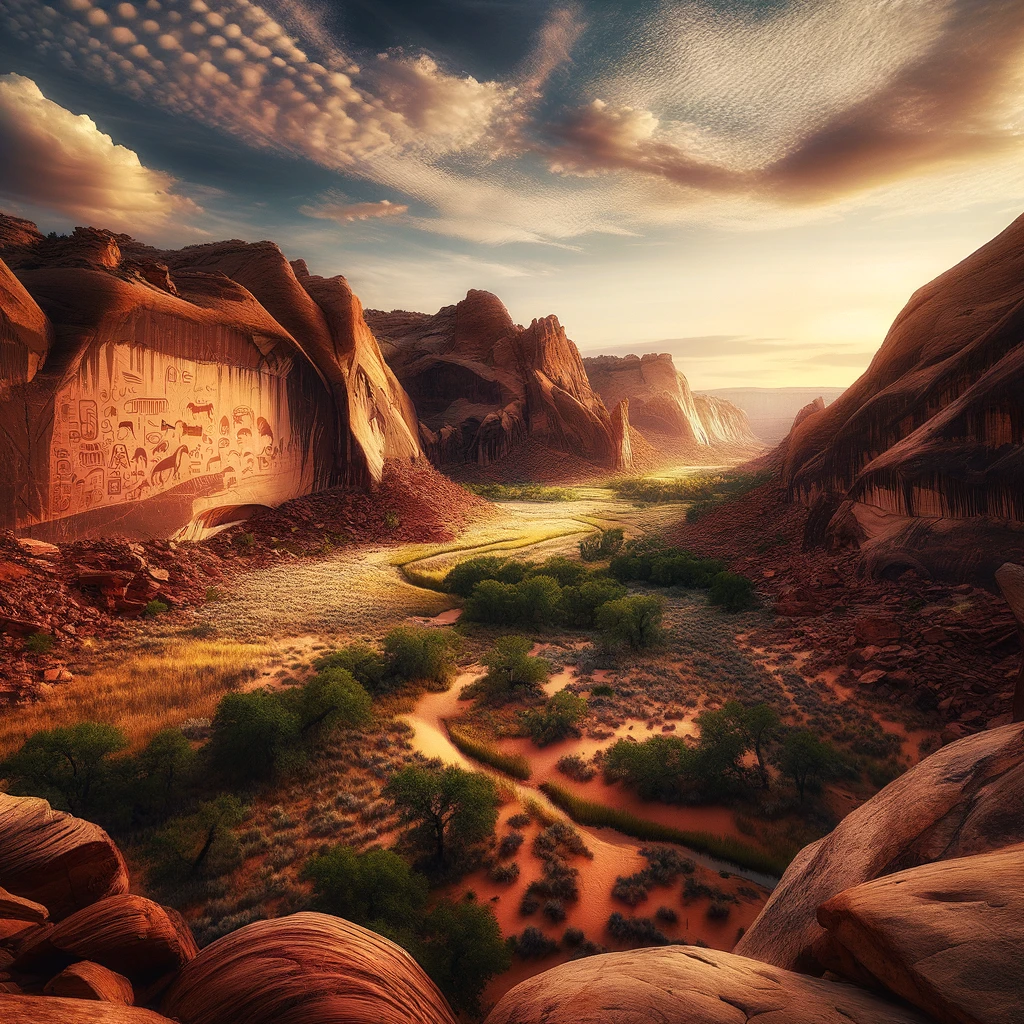
Interpreting the Figures
The Barrier Canyon Style is particularly notable for its large anthropomorphic figures, some towering as tall as nine feet, often depicted with missing eyes or limbs and adorned with vertical body markings. These haunting images, along with others depicting beings with what appear to be wings or rays of power, such as the ‘Buckhorn Wash Angels,’ have sparked various interpretations and theories about their meanings.
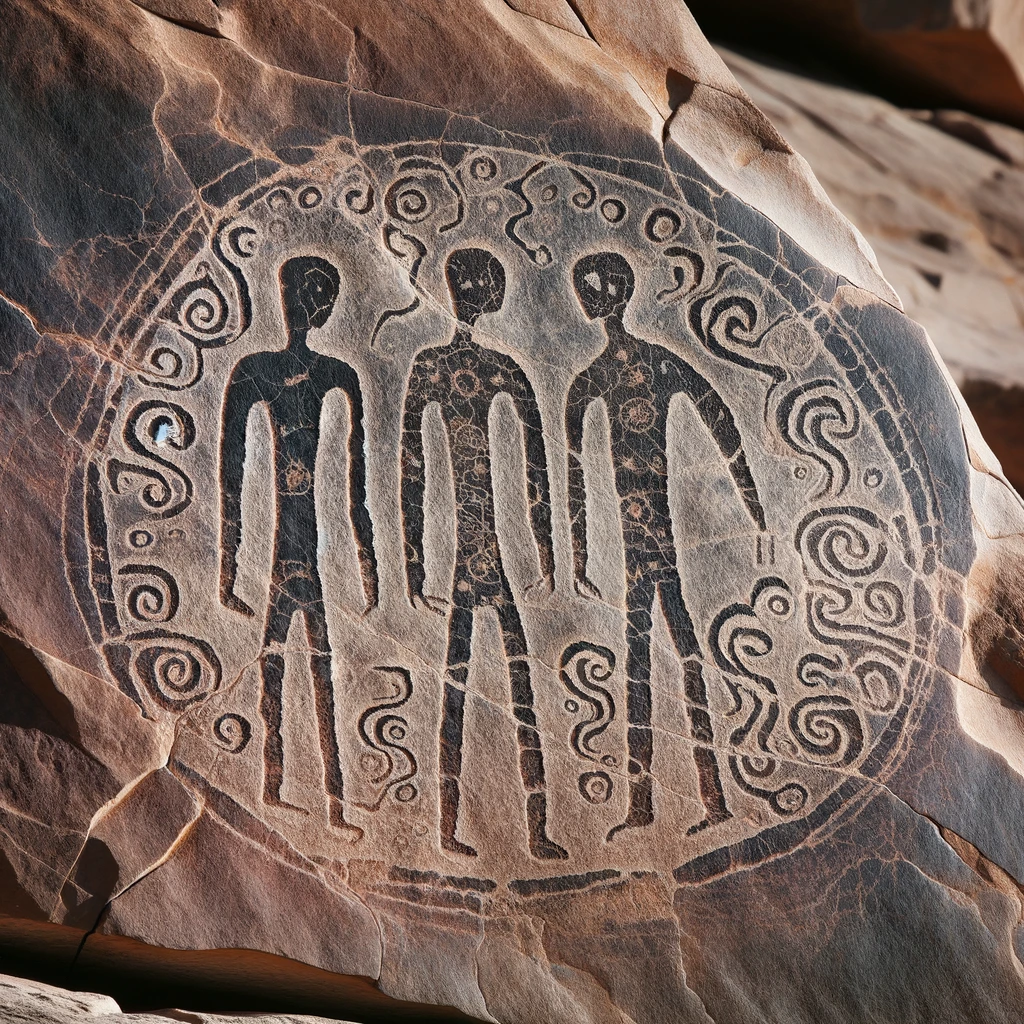
Indigenous Perspectives on Utah’s Ancient Artworks
To fully appreciate the depth and breadth of Utah’s ancient petroglyphs and pictographs, it is essential to incorporate the perspectives of the Indigenous peoples whose ancestors created these remarkable artworks. Indigenous scholars and elders offer insights that are not only vital for a comprehensive understanding of the rock art but also embody the living connections to these lands and their histories. Their interpretations provide context that is rooted in centuries of oral traditions, cultural practices, and spiritual beliefs, offering a lens through which we can view these artworks in a way that respects their original significance.
“Rock art is not merely art. It is a sacred text, inscribed upon the earth by our ancestors, these images tell stories of our beginnings, our struggles, and our connection to the land and the cosmos. They are a testament to our resilience and our understanding of the natural world.”
Navajo elder
Indigenous interpretations often focus on the spiritual and cosmological significance of the petroglyphs and pictographs. For many Native American tribes, these images serve as a bridge between the physical and spiritual worlds, offering guidance, wisdom, and insights into the values and beliefs of their communities. The figures depicted in the rock art are not seen as mere representations but as living entities, with each symbol carrying specific meanings and messages intended to be passed down through generations.
“The spirals, animals, and anthropomorphic figures you see in these artworks are more than decorative elements. They represent our ancestors’ deep understanding of the cycles of life, the movements of celestial bodies, and our interconnectedness with all living things. These symbols guide us in our ceremonies and remind us of our responsibilities to Mother Earth.”
Hopi scholar
Incorporating Indigenous perspectives also involves acknowledging the sacredness of these sites. Many petroglyphs and pictographs are located in areas considered sacred by Indigenous peoples, serving as focal points for ceremonies and prayers. Respecting these spaces means recognizing their significance beyond their aesthetic value, understanding that they are integral to the cultural and spiritual lives of the Indigenous communities.
“Each visit to these sacred sites is a pilgrimage, an opportunity to connect with our ancestors and the land, we approach these places with reverence, seeking knowledge, healing, and renewal. It is vital that all who come here do so with respect and an open heart.”
Ute spiritual leader
By weaving Indigenous perspectives into our exploration of Utah’s rock art, we not only honor the original meanings and purposes of these ancient artworks but also foster a deeper appreciation for the rich cultural heritage they represent. Listening to the voices of Indigenous scholars and elders allows us to approach these sites with the respect and sensitivity they deserve, ensuring that the stories and wisdom of the past continue to enlighten and inspire future generations.
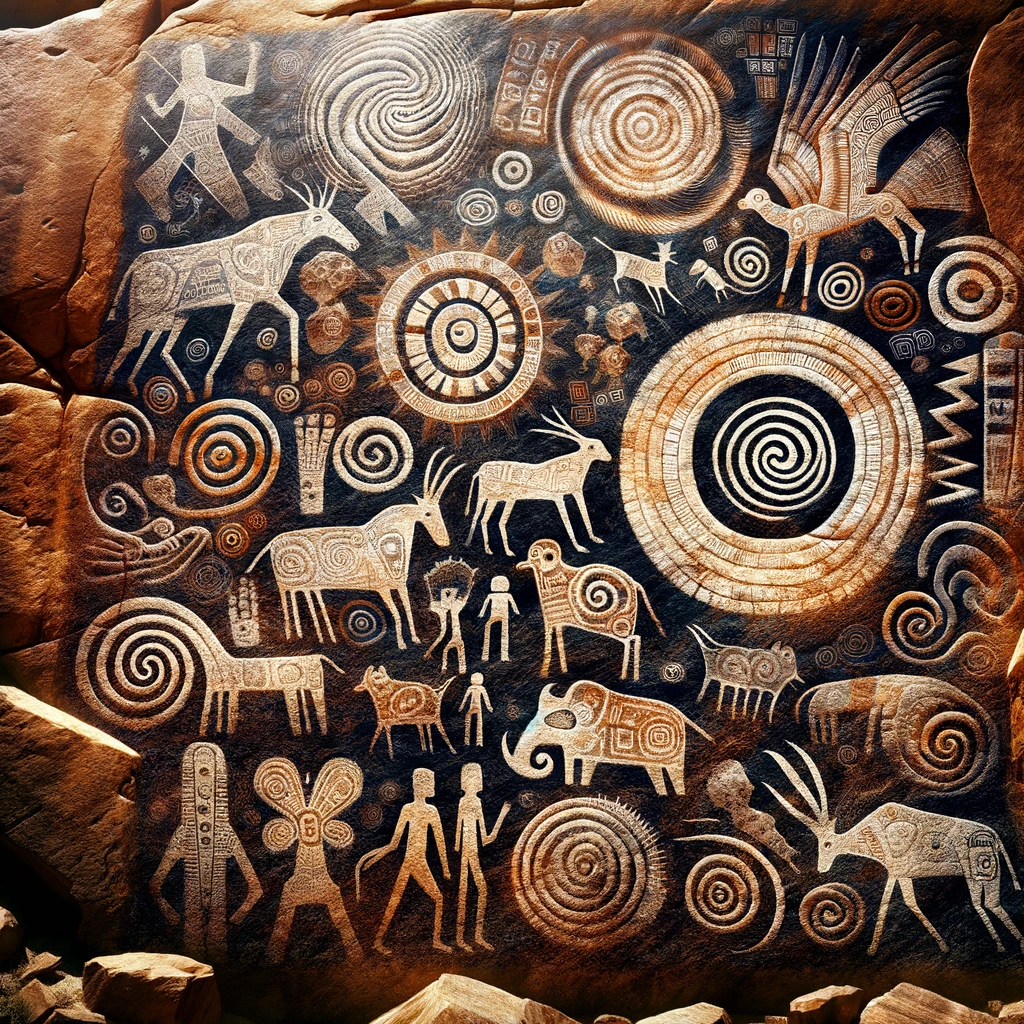
Distinguishing Between Scholarly Interpretations and Speculative Theories
The Lure of the Unexplained
Among the many interpretations of Utah’s petroglyphs and pictographs, speculative theories such as those suggesting ancient alien encounters occupy a unique place. These theories propose that some of the mysterious symbols and figures found in Utah’s rock art could be evidence of extraterrestrial visitors in ancient times. The notion that these artworks might depict or even commemorate encounters between ancient humans and beings from beyond our world adds a layer of intrigue and mystery to the study of these ancient images.
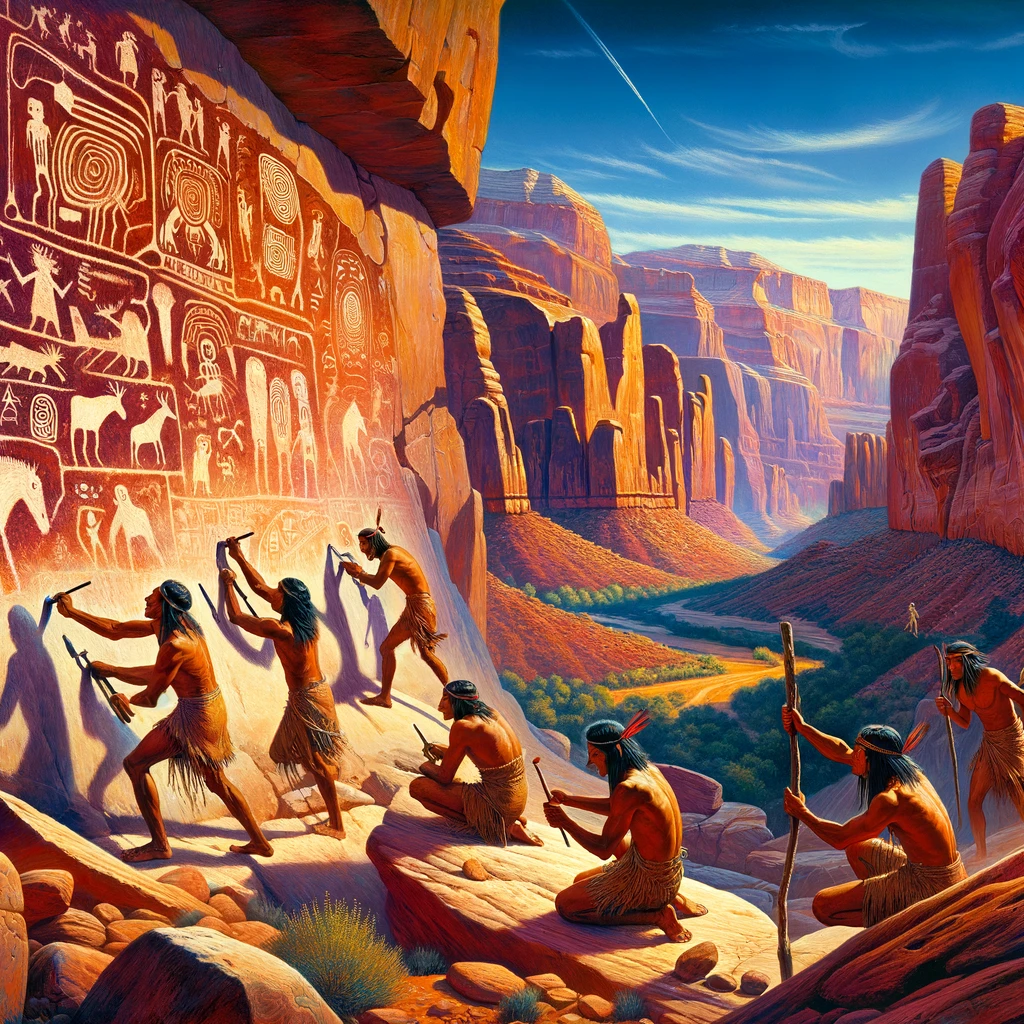
Distinguishing Between Interpretations
However, it is crucial to clearly distinguish these speculative theories from scholarly and Indigenous interpretations. Scholarly research into the petroglyphs and pictographs is grounded in archaeology, anthropology, and the study of Indigenous cultures and histories. This research relies on material evidence, comparative studies, and the oral traditions of Indigenous peoples to interpret the rock art within its cultural and historical context.
Indigenous interpretations, on the other hand, are rooted in the lived experiences, spiritual beliefs, and oral histories of the Native American tribes whose ancestors created these artworks. These perspectives offer invaluable insights into the cultural and spiritual significance of the petroglyphs and pictographs, viewing them as sacred texts, historical records, and integral parts of a living cultural heritage.

The Importance of Context
Speculative theories, while they capture the imagination, often lack the empirical support and cultural context that underpin scholarly and Indigenous interpretations. Emphasizing the speculative nature of theories about ancient aliens or other extraordinary claims can help prevent misunderstandings about the origins and meanings of the rock art. It ensures that readers appreciate the artworks for their rich cultural, spiritual, and historical significance, beyond the sensational explanations offered by popular media.
Furthermore, while exploring speculative theories can be a fascinating exercise in imagination, it is essential to approach these ideas with a critical mind. Recognizing the difference between speculation and evidence-based interpretations respects the integrity of the archaeological record and honors the cultural heritage of Indigenous peoples.
Conclusion to Distinguishing Between Scholarly Interpretations and Speculative Theories
In conclusion, while speculative theories such as ancient alien encounters add a layer of intrigue to the study of Utah’s ancient petroglyphs and pictographs, it is vital to maintain a clear distinction between these theories and the scholarly and Indigenous interpretations that are grounded in evidence and cultural understanding. By doing so, we can ensure that our exploration of these ancient artworks remains respectful, informed, and rooted in a deep appreciation for the complex tapestry of human history and cultural expression they represent.
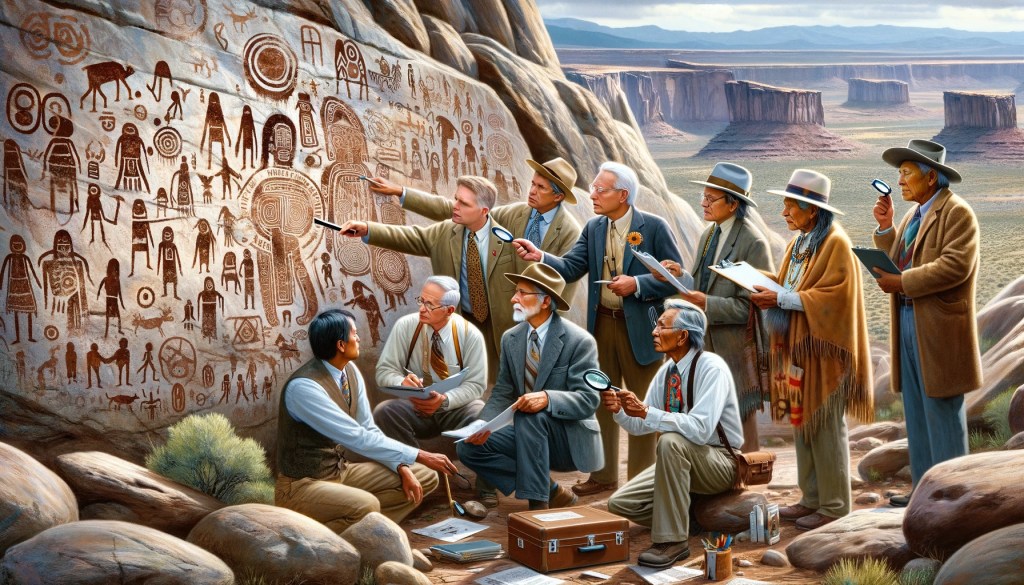
As we venture into the realm of interpreting Utah’s ancient petroglyphs and pictographs, it is crucial to distinguish between the foundational scholarship that has long guided our understanding of these artworks and the more speculative theories that capture the public imagination. Scholarly interpretations of rock art are grounded in rigorous archaeological methods, ethnographic comparisons, and the application of cultural and historical knowledge. These interpretations seek to understand the petroglyphs and pictographs in their specific cultural and environmental contexts, drawing on a wide array of evidence from archaeological excavations, comparative studies of similar artworks across different cultures, and, importantly, the oral traditions and historical records of Indigenous peoples.
In contrast, speculative theories, such as those suggesting ancient alien encounters, often emerge outside the traditional academic disciplines. These theories typically draw upon visual similarities between the ancient artworks and modern depictions of extraterrestrial life, proposing that such resemblances hint at contact with otherworldly beings. While captivating, these interpretations tend to rely more on conjecture than on the material evidence and methodological rigor that underpin scholarly research. They often do not account for the complexities of symbolic representation in Indigenous cultures or the ways in which cultural meanings can be deeply embedded in specific historical and environmental contexts.

The appeal of speculative theories lies in their ability to challenge our perceptions and to suggest possibilities that transcend ordinary explanations. However, it is essential to approach them with a critical mind and to recognize the distinction between theories grounded in a wealth of academic research and those that, despite their imaginative allure, lack empirical support. By maintaining this distinction, we can appreciate the intriguing nature of speculative ideas while giving due respect to the depth and richness of knowledge that scholarly research and Indigenous wisdom offer about the ancient peoples of Utah and their artistic legacy.
As we delve into the various theories surrounding Utah’s petroglyphs and pictographs, let us keep in mind this important distinction, allowing it to guide our exploration and understanding of these ancient artworks. In doing so, we ensure a balanced and respectful approach to interpreting the rich tapestry of human expression they represent.
Theories of Origin: Earthly or Extraterrestrial?
While some suggest that these figures represent spiritual or shamanistic visions, possibly induced by the use of hallucinogens known to provoke extraordinary experiences, others speculate about the possibility of ancient astronaut theories. This latter view posits that the unique features of the rock art, such as large, hollow eyes and triangular-shaped heads, may depict extraterrestrial visitors that ancient peoples encountered.
Despite these differing interpretations, the true meaning behind these enigmatic figures remains a subject of debate among scholars and enthusiasts. The rock art of Utah continues to captivate the imagination, offering endless possibilities for interpretation and understanding of the ancient peoples who left behind these remarkable works.
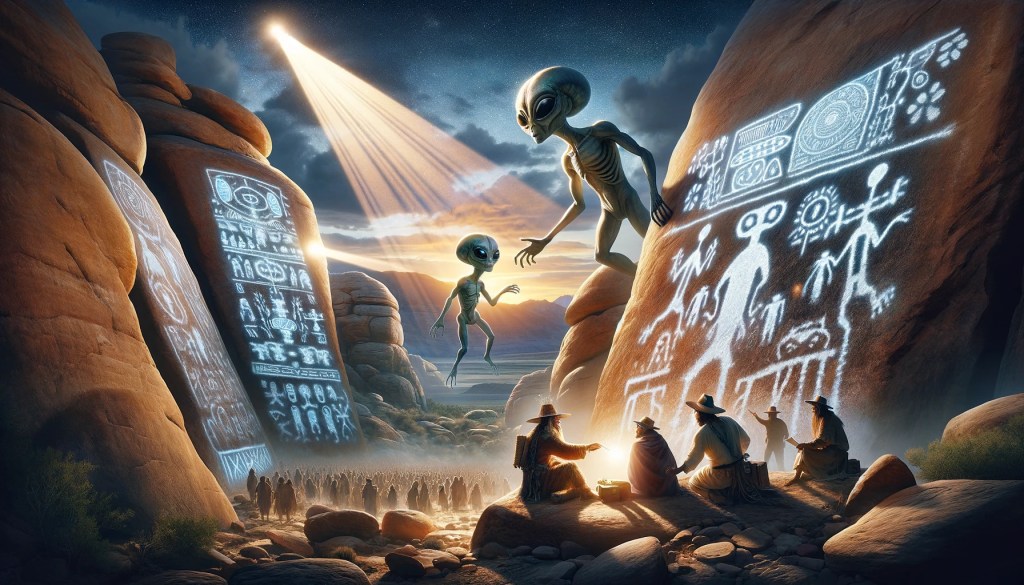
Visiting Utah’s Rock Art Sites
For those interested in exploring these ancient messages firsthand, Utah offers numerous sites renowned for their petroglyphs and pictographs. Each site provides a unique glimpse into the past and an opportunity to speculate on the meanings and origins of these fascinating artworks. Whether viewed as historical records, spiritual expressions, or evidence of ancient extraterrestrial encounters, Utah’s rock art stands as a significant cultural and historical legacy worth preserving and studying.
Interpreting the Ancient Messages of Utah’s Rock Art
Utah’s ancient rock art, with its petroglyphs and pictographs, offers a unique lens through which we can glimpse the lives and beliefs of its ancient peoples. The interpretations of these ancient messages are vast and varied, reflecting a rich tapestry of life, spirituality, and possibly even early human encounters with the cosmos.

The Complexity of Interpretation
The meanings behind Utah’s rock art are deeply speculative, with scholars and enthusiasts proposing a myriad of interpretations. Some suggest that these artworks depict everyday life, spiritual beliefs, and significant cosmic events. The symbols, ranging from human figures and animals to intricate geometric shapes and patterns, could represent a visual language or storytelling method used by ancient cultures to communicate with future generations or with the divine.
A fascinating aspect of Utah’s rock art is the recurring depiction of figures that some believe to represent celestial beings or objects. This has sparked theories about ancient alien visitors and their possible interactions with early human societies. The Barrier Canyon Style, characterized by its large, anthropomorphic figures, often lacks eyes, arms, and legs, and sometimes features vertical body markings, adding an otherworldly quality to the depictions.
Recent Insights and Theories
Recent analysis suggests that some of Utah’s most famous rock art, such as the Barrier Canyon Style, might be much younger than previously thought, with estimates now placing them between 900 to 2,000 years old. This timing aligns the creation of these artworks with the Fremont people, adding another layer to our understanding of the region’s ancient inhabitants.
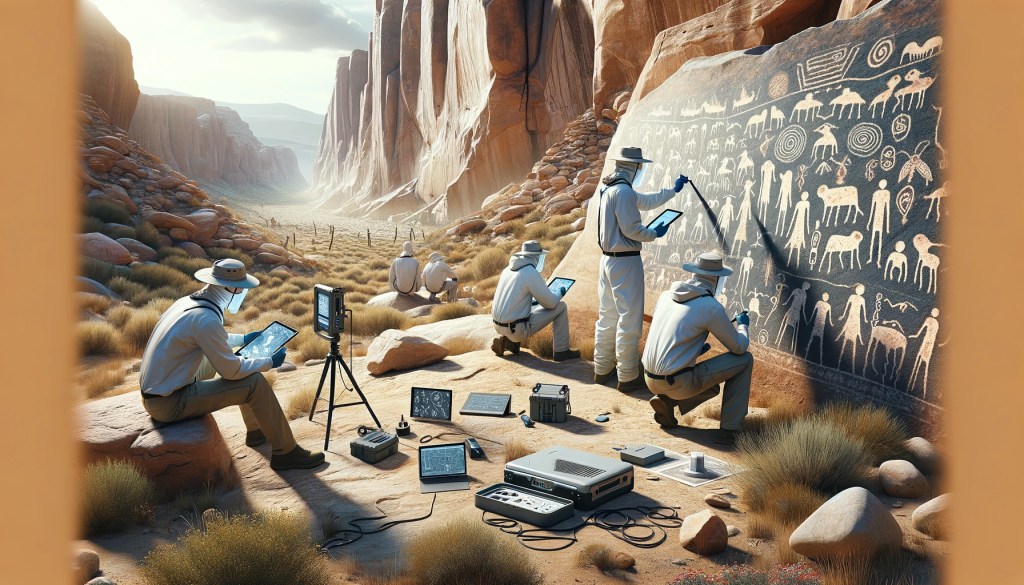
The interpretations of these artworks are influenced by contemporary cultural dynamics and are embedded in narratives already created about Native Americans by various modern sources. This complicates our understanding of the rock art and challenges us to think critically about how we interpret and represent these ancient messages today.
Visiting and Preserving Utah’s Rock Art
Places like the Parowan Gap serve as outdoor galleries where visitors can marvel at petroglyphs that some theorize to function as ancient calendars or spiritual sites. Events like the Summer Solstice gathering at Parowan Gap highlight the cultural and historical significance of these locations, drawing attention to the need for their preservation.
As we seek to interpret Utah’s ancient rock art, it’s crucial to approach these artworks with respect and an awareness of their cultural significance. By promoting better understanding and protection of these sites, we ensure that they continue to inspire and teach future generations about the rich histories and mysteries they embody.
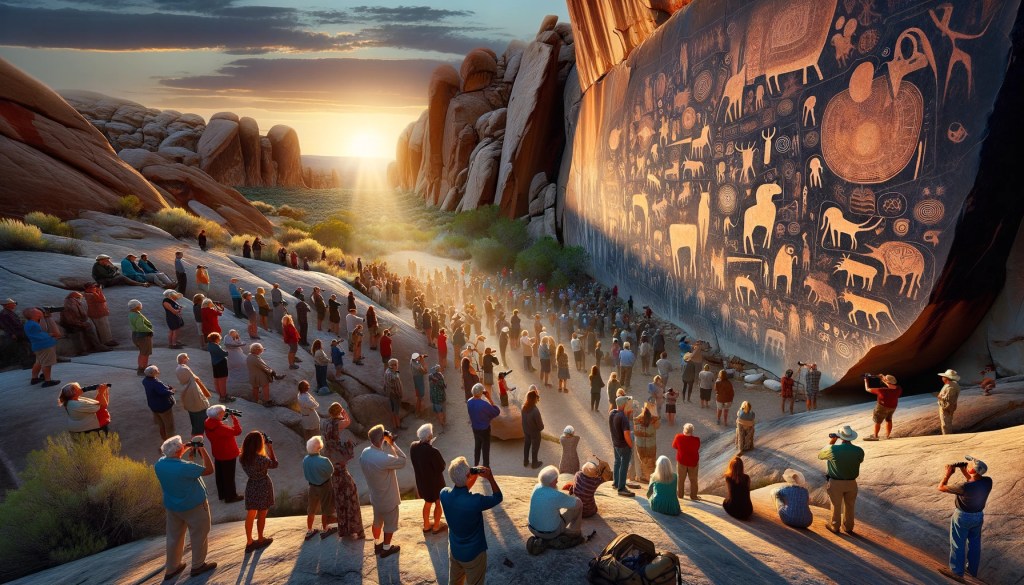
Connections to the Cosmos: The Ancient Alien Theory
The notion that some petroglyphs may be references to ancient aliens is a captivating theory for many, including myself. Proponents of this theory argue that certain symbols resemble modern representations of extraterrestrial life and unidentified flying objects (UFOs). This perspective suggests that our ancestors were not merely documenting their surroundings but perhaps encounters with beings from beyond our world. While mainstream archaeology and anthropology may view these interpretations with skepticism, the possibility adds an intriguing layer to the mystery of Utah’s rock art.
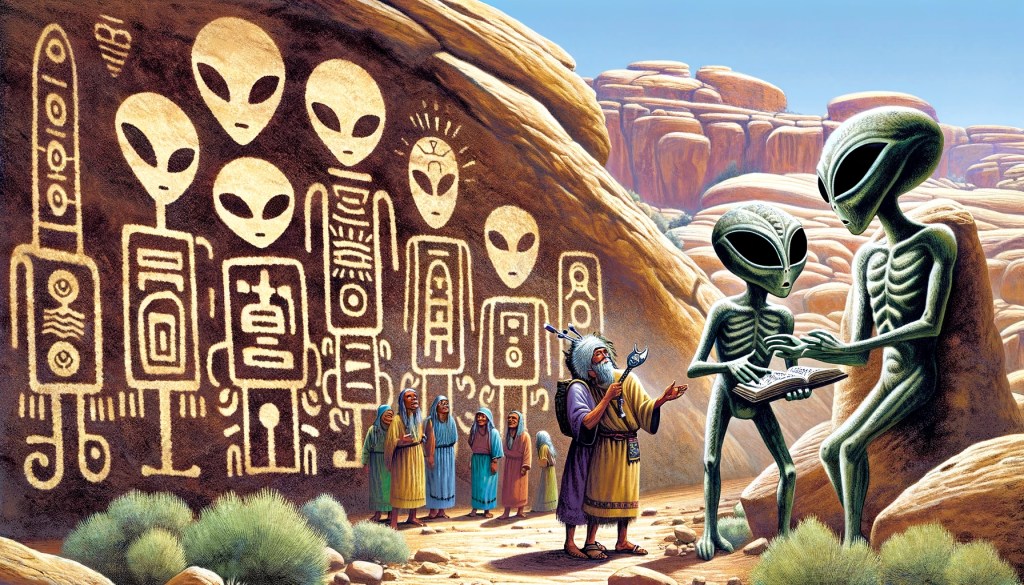
The ancient alien theory, when applied to the enigmatic rock art of Utah, opens a fascinating chapter in the interpretation of these ancient messages. This theory suggests that some petroglyphs and pictographs found in Utah might not just be artistic expressions or spiritual symbols but could represent encounters with extraterrestrial beings.
The Theory in Depth
Advocates of the ancient alien theory argue that specific symbols in Utah’s rock art, such as those seen in Sego Canyon, bear a striking resemblance to modern depictions of extraterrestrial life and unidentified flying objects (UFOs). This perspective proposes that our ancestors might have been documenting not just their surroundings but also encounters with beings from beyond our world.
The Barrier Canyon Style: A Case Study
The Barrier Canyon Style, characterized by its large, anthropomorphic figures, some as tall as nine feet, with missing eyes or limbs and sometimes featuring vertical body markings, often comes under this theory. These ghost-like images, with their otherworldly attributes, have fueled speculation about extraterrestrial influences. The presence of unusual features such as strange eyes, legless bodies, and apparent wings has led some to suggest these might be depictions of alien beings.

However, there’s also a counterargument grounded in shamanistic traditions of the Archaic peoples. Researchers like Polly Schaafsma suggest that these figures represent shamanistic art associated with ritual activities, where the ‘spirit figures’ frequently shown holding snake forms and incorporating water/life-giving symbols in their torsos hint at a shamanistic tradition alive among these Western Archaic peoples. The extraordinary experiences of shamans, often induced by the use of hallucinogens, were communicated through art, suggesting these pictographs and petroglyphs might represent otherworldly voyages and encounters with spirits rather than extraterrestrial visitors.
Contemporary Interpretations and Preservation
Regardless of the theory one subscribes to, the mystery of Utah’s rock art continues to captivate. The ancient alien theory adds an intriguing layer to our understanding of these ancient artworks, challenging us to consider possibilities beyond our current understanding of history and prehistory. Yet, it’s crucial to approach these interpretations with respect for the indigenous cultures that created them and a commitment to preserving these invaluable pieces of human history for future generations to study and admire.
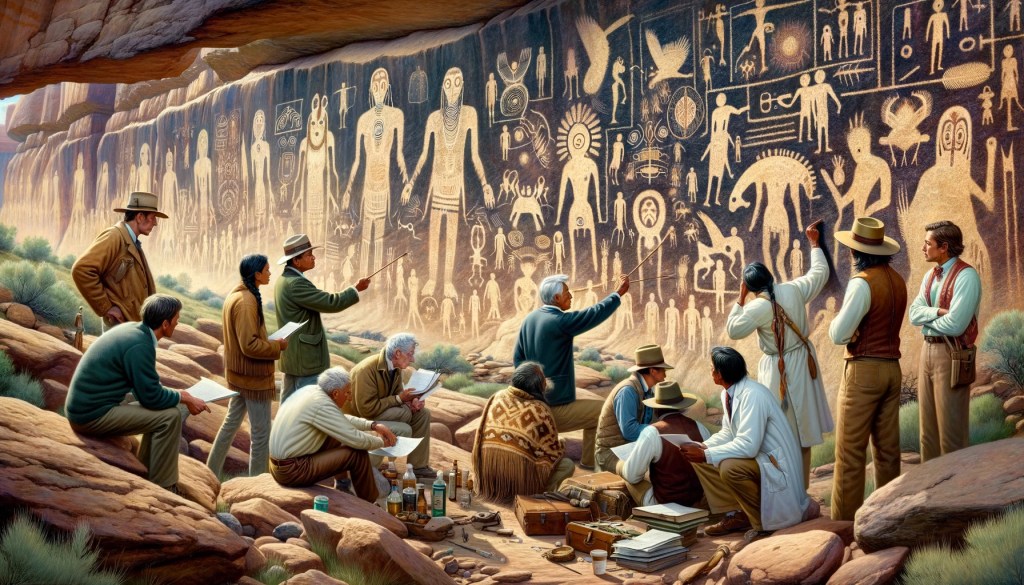
In conclusion, while the ancient alien theory provides a fascinating perspective on Utah’s rock art, it is just one of many interpretations. The true meaning behind these ancient artworks may remain elusive, but they undeniably enrich our understanding of the past and continue to spark our imagination about the origins and experiences of ancient peoples.
To deepen the analysis of Utah’s petroglyphs and pictographs and the various theories surrounding their origins and meanings, it’s vital to explore how these interpretations contrast and what they signify about our comprehension of ancient cultures. The differences in interpretation, especially when examining the speculative theories such as the ancient alien hypothesis, reveal not only the complexity of these artworks but also the broader human quest to understand our past.
Differing Interpretations
Interpretations of petroglyphs and pictographs range from viewing them as historical records of daily life, spiritual and ceremonial depictions, to markers of celestial events. Indigenous interpretations, based on oral traditions and cultural knowledge, offer insights into the spiritual significance of these artworks, seeing them as sacred texts that speak to the relationships between people, the natural world, and the cosmos.
In contrast, the ancient alien hypothesis suggests that some rock art depicts encounters with extraterrestrial beings or technology. This theory often points to figures with unusual features or symbols that resemble modern depictions of aliens or UFOs as evidence. Critics argue that this perspective projects contemporary imaginations onto ancient artworks without considering the cultural and historical contexts from which they emerged.
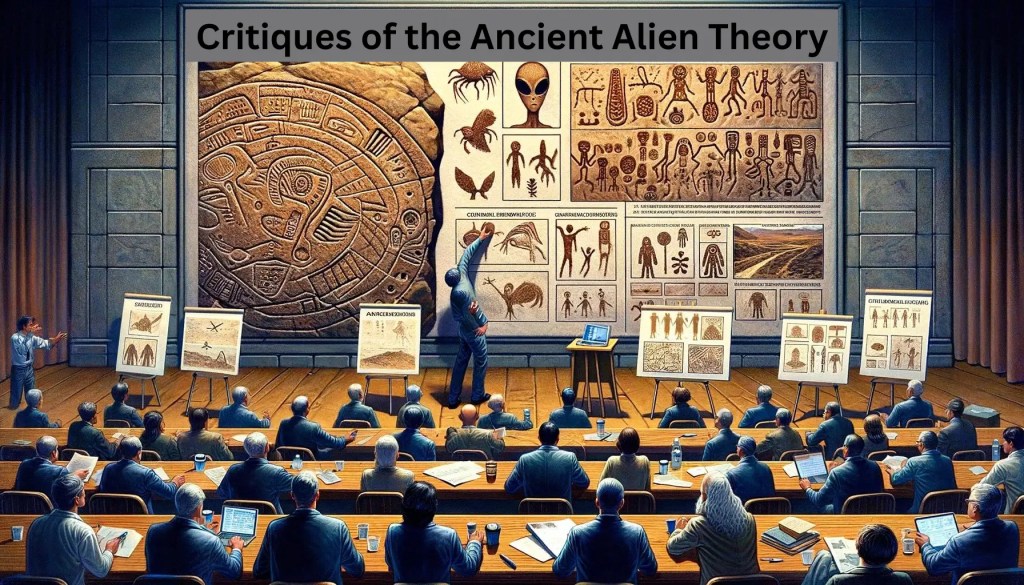
Implications of Differing Viewpoints
The range of interpretations underscores the complexity of rock art and the challenges in understanding the intentions and experiences of ancient peoples. These differing viewpoints can enrich our understanding by highlighting the diverse ways humans interpret visual symbols across cultures and time periods. However, they also raise questions about the projection of modern biases and imaginaries onto ancient artifacts.
A critical examination of the evidence for speculative theories like the ancient alien hypothesis reveals several implications:
- Cultural Misinterpretation: There’s a risk of misinterpreting cultural symbols and spiritual beliefs of ancient peoples when viewing them through a modern, speculative lens.
- Scientific Rigor: The scientific community generally requires physical evidence and rigorous methodology to support hypotheses. The ancient alien theory, while intriguing, often lacks the concrete evidence that archaeologists and anthropologists rely on.
- Respect for Indigenous Knowledge: Indigenous perspectives provide crucial insights into the meanings of petroglyphs and pictographs. Speculative theories that overlook these insights can inadvertently disrespect the cultural heritage and knowledge of Indigenous peoples.
Critical Examination of Evidence
A balanced analysis would weigh the intriguing aspects of speculative theories against the rich body of knowledge derived from archaeological evidence, ethnographic research, and Indigenous oral traditions. While the ancient alien hypothesis captures the imagination, the evidence supporting more grounded interpretations—such as those focusing on symbolism, social structures, and environmental interactions—offers a more nuanced understanding of ancient rock art.
For instance, the anthropomorphic figures in Barrier Canyon Style art, sometimes cited in support of the ancient alien theory, can also be interpreted through shamanistic practices known among Indigenous cultures, where altered states of consciousness, achieved through rituals and possibly the use of natural hallucinogens, allowed shamans to experience and depict otherworldly journeys.

In conclusion, while it’s important to explore all theories with an open mind, a critical analysis grounded in archaeological evidence, ethnographic context, and respect for Indigenous knowledge offers the most comprehensive understanding of Utah’s ancient petroglyphs and pictographs. Engaging with these artworks through multiple lenses enriches our appreciation and understanding of the ancient peoples who created them, while also reminding us of the limits of our interpretations.
Analyzing the Implications of Utah’s Rock Art Interpretations
Within the rich tapestry of narratives surrounding Utah’s petroglyphs and pictographs, the balance between descriptive allure and analytical depth provides a comprehensive lens through which we can view these ancient artworks. This section aims to delve into the broader implications of interpreting Utah’s rock art, exploring how these interpretations reflect upon our understanding of history, culture, and humanity. This analytical exploration can be seamlessly integrated after the detailed descriptions of the petroglyphs and pictographs and their speculative and scholarly interpretations, offering a reflective pause before concluding remarks on preservation and engagement with Indigenous perspectives.
Reflecting on Historical Narratives
The interpretations of Utah’s rock art do not merely serve as academic exercises; they actively shape our understanding of the past. Scholarly and Indigenous interpretations ground these artworks within their cultural and historical contexts, offering insights into the social structures, spiritual beliefs, and daily lives of ancient peoples. For instance, the depiction of hunting scenes, celestial events, and shamanistic figures speaks volumes about the interwoven relationship between the ancient inhabitants and their natural environment, as well as their cosmological views. By analyzing these depictions, we not only reconstruct historical narratives but also recognize the complexity and sophistication of ancient cultures, challenging any preconceived notions of “primitivism” associated with prehistoric peoples.

Cultural Insights and Identity
Beyond historical understanding, the interpretations of rock art offer profound cultural insights. Indigenous perspectives, in particular, emphasize the spiritual and symbolic significance of these artworks, reflecting a worldview where art, spirituality, and the land are inseparably connected. This challenges modern perspectives that often compartmentalize religion, art, and nature, inviting a holistic understanding of human culture. Furthermore, these interpretations highlight the continuity of Indigenous cultures, underscoring the importance of rock art as a living cultural heritage that connects present-day Indigenous communities with their ancestors.
Humanity’s Universal Quest for Meaning
At its core, Utah’s rock art and its myriad interpretations speak to the universal human quest for meaning and expression. The very act of creating these artworks—carving intricate designs into rock faces, painting vivid images in remote canyons—demonstrates a deep-seated human desire to communicate, commemorate, and connect. The speculative theories, while often lacking empirical support, underscore our fascination with the unknown and our innate tendency to seek explanations that transcend our current understanding. This reflects a broader aspect of human nature: the drive to explore, imagine, and speculate about our place in the universe.
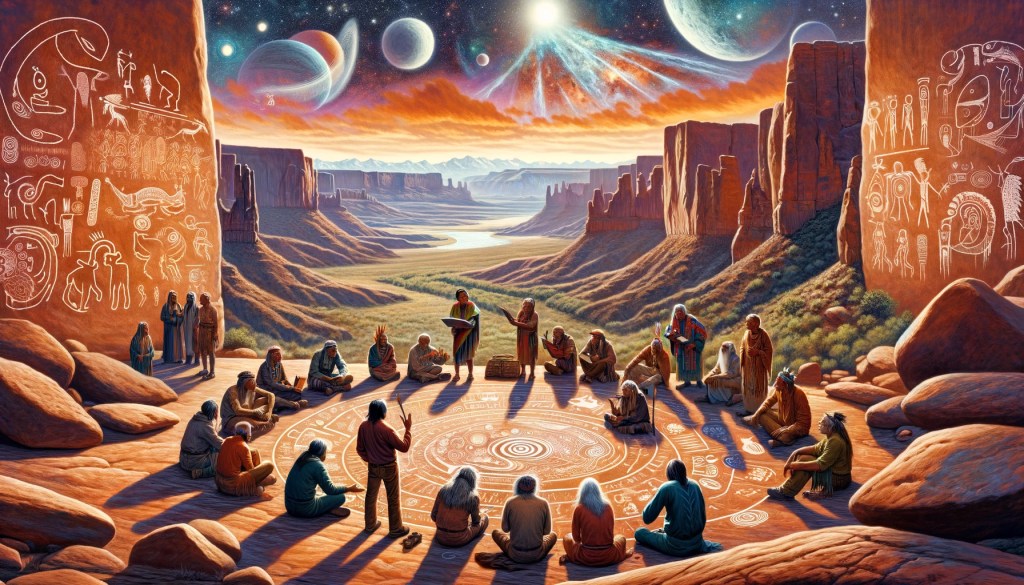
The Role of Interdisciplinary Approaches
The analysis of Utah’s petroglyphs and pictographs benefits greatly from an interdisciplinary approach, combining archaeology, anthropology, art history, and Indigenous studies. This approach not only enriches our understanding of the artworks themselves but also illustrates how different fields of study can converge to provide a multifaceted view of human history and culture. It emphasizes the value of collaborative research and the inclusion of diverse perspectives in constructing a more nuanced and comprehensive narrative of the past.
By balancing descriptive vividness with analytical depth, we gain a richer appreciation for Utah’s ancient rock art and its significance. This exploration not only enhances our understanding of the artworks but also encourages reflection on broader themes of human history, cultural identity, and our collective quest for meaning. As we continue to study and interpret these ancient messages, we are reminded of the enduring power of art to connect us across time and space, offering insights into the past that shape our understanding of what it means to be human.
Where to Witness Utah’s Petroglyphs and Pictographs
Utah is renowned for its extensive and fascinating collection of ancient petroglyphs and pictographs, offering a unique window into the lives of the region’s earliest inhabitants. These sites not only captivate with their historical and cultural significance but also spark the imagination with their mysterious and often unexplained imagery.

Nine Mile Canyon
Dubbed “the world’s longest art gallery,” Nine Mile Canyon is a treasure trove of rock art, primarily attributed to the Fremont Culture. The canyon is filled with thousands of petroglyphs and pictographs that span a vast period, from ancient times through to the 1800s, depicting everything from daily life to abstract figures that continue to puzzle researchers today. The canyon is about 40 miles long and has been a significant site for various cultures over the centuries, including the Ute people who added their own styles to the rock art. Today, it’s protected as a historic site, with over 63 archaeological sites listed on the U.S. National Register of Historic Places, including rock art sites and ancient dwellings.
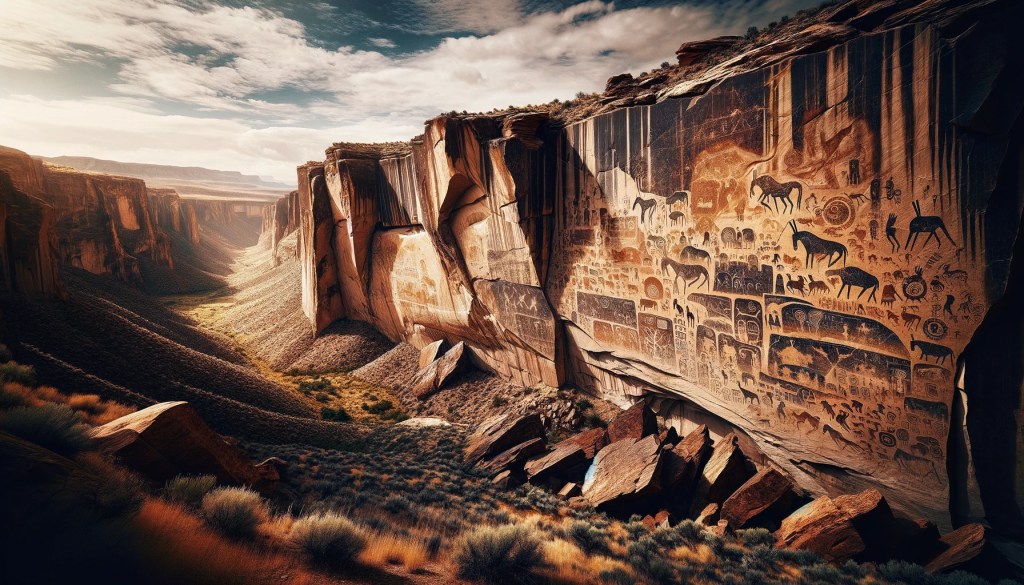
Sego Canyon
Sego Canyon is another fascinating site, home to a variety of rock art that includes the Barrier Canyon Style, known for its large, ghostly anthropomorphic figures. Some of these figures are interpreted by enthusiasts of the ancient alien theory as depictions of celestial beings, due to their unusual features such as large, hollow eyes, and missing limbs, which they argue could represent extraterrestrial life.
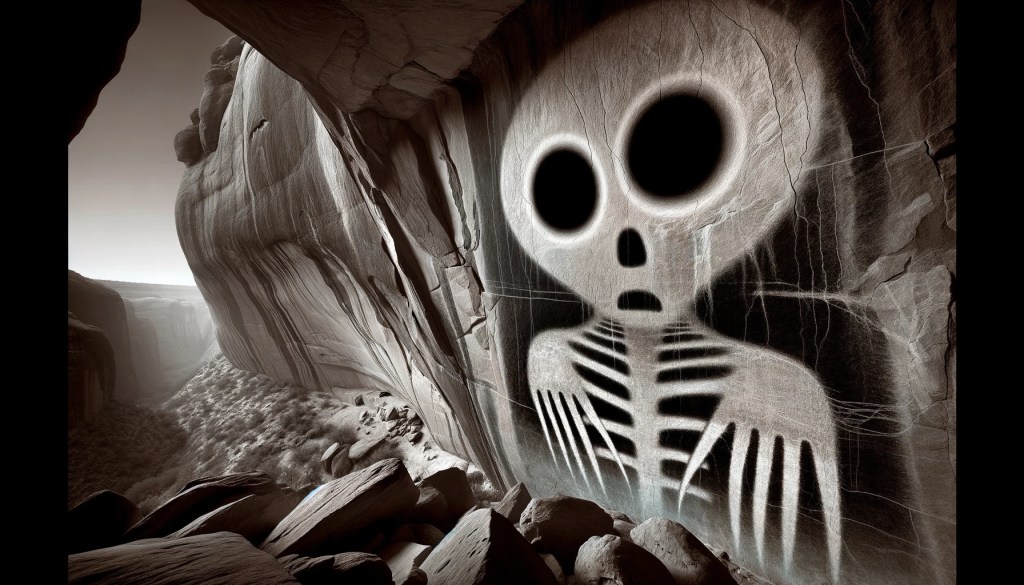
San Rafael Swell
The San Rafael Swell features the remarkable Buckhorn Draw Pictograph Panel, showcasing Barrier Canyon-style figures. This area is known for its dramatic landscapes and ancient rock art, making it a prime location for those interested in history, archaeology, and the natural beauty of Utah’s wilderness.
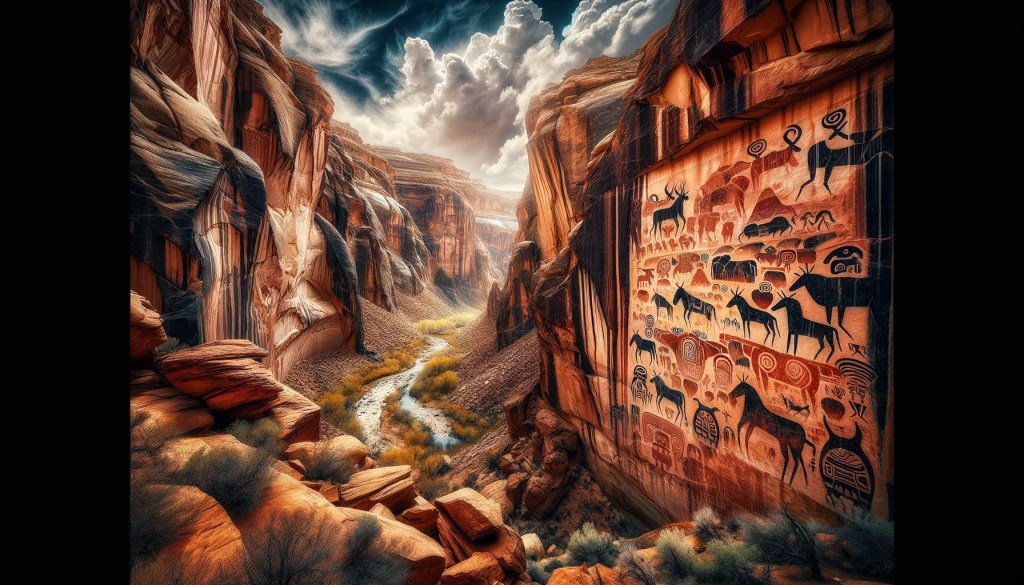
Newspaper Rock State Historic Monument
Located in the Indian Creek area, Newspaper Rock presents one of the largest collections of petroglyphs, chronicling over 2,000 years of human activity. The site is easily accessible and offers a clear glimpse into the lives of the ancient people who once inhabited the region, with hundreds of figures depicting animals, humans, and abstract shapes.
When visiting these sites, it’s crucial to approach with respect and care to preserve these irreplaceable glimpses into the past. Many of the sites are easily accessible by car, and for a more immersive experience, some, like Nine Mile Canyon, can also be explored by bike, allowing for a closer and more personal view of the art. It’s advised to take necessary precautions such as bringing plenty of food and water, and to respect the land by not touching the rock art or disturbing the area.
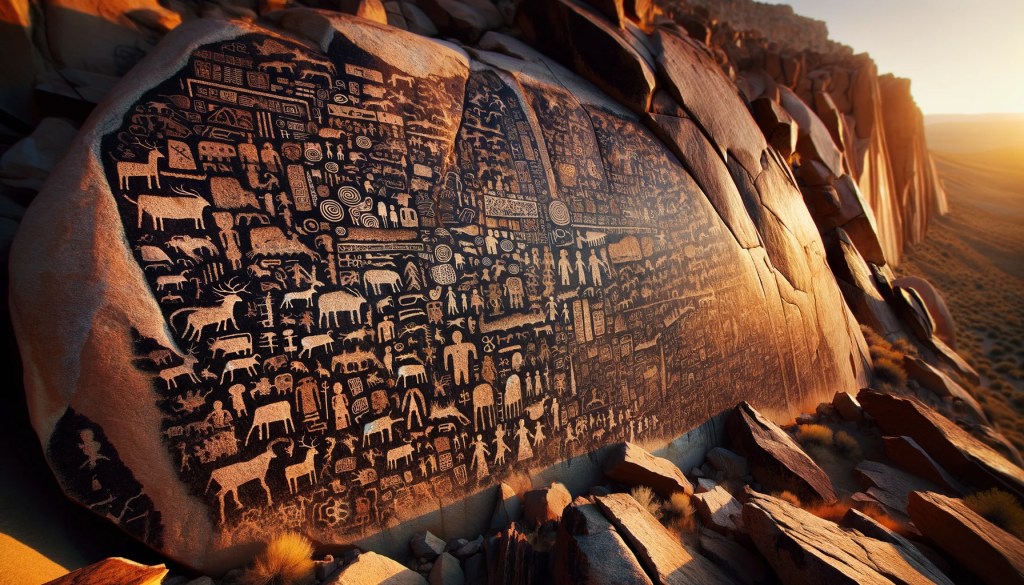
These ancient sites offer a profound connection to the past, allowing us to speculate on the lives, beliefs, and artistic expressions of Utah’s earliest inhabitants. Whether you’re drawn to these locations by an interest in history, a passion for outdoor exploration, or curiosity about ancient cultures, Utah’s petroglyphs and pictographs offer an unforgettable journey into the heart of the ancient American West.
Preserving the Legacy
Preserving the ancient petroglyphs and pictographs scattered across Utah is more than an act of cultural respect; it’s a commitment to maintaining a tangible connection to the past for future generations. These ancient artworks, which have withstood the tests of time, offer invaluable insights into the lives, beliefs, and artistic expressions of the peoples who inhabited the region thousands of years ago. As such, their preservation is a responsibility that falls to all who visit, study, or simply marvel at their existence.

Addressing Contemporary Challenges in the Preservation of Utah’s Rock Art
As we delve into the ancient world of Utah’s petroglyphs and pictographs, it is imperative to acknowledge the contemporary challenges that threaten these irreplaceable cultural and historical treasures. The preservation of these sites is fraught with challenges, including vandalism, climate change, and the impact of tourism. Addressing these issues is not only crucial for safeguarding the art itself but also for maintaining the integrity of the cultures and histories they represent. This discussion can be integrated after exploring the importance of preserving these sites, serving as a critical examination of the threats and a call to action for collective responsibility.
The Scourge of Vandalism
Vandalism presents a direct and immediate threat to rock art sites. Acts of graffiti, carving, and other deliberate damages disrespect and destroy the cultural heritage these artworks embody. Such acts not only erase parts of history but also degrade the spiritual and ancestral significance attributed to these sites by Indigenous communities. Combating vandalism requires strict enforcement of legal protections, increased surveillance, and public education about the value and fragility of rock art.
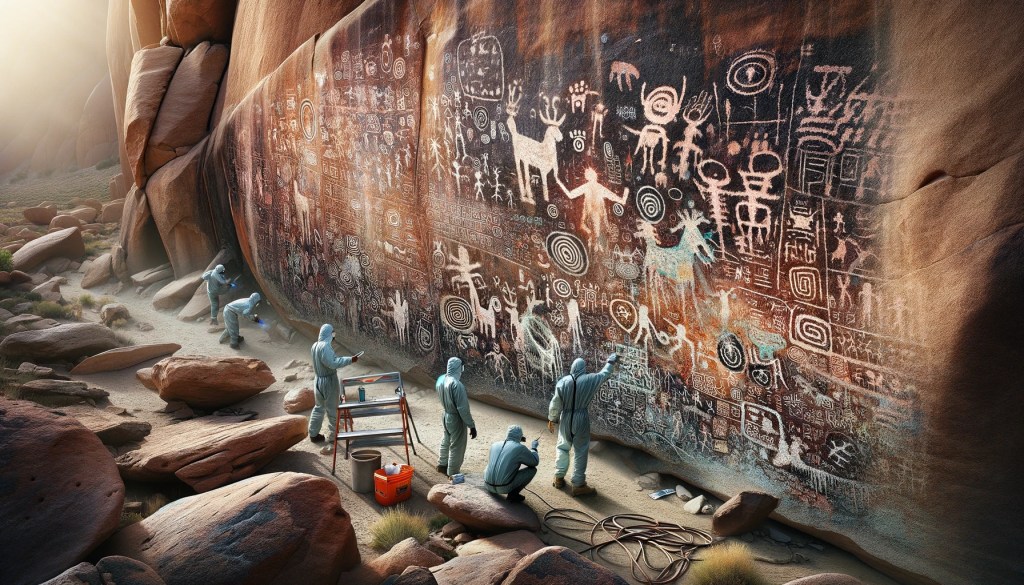
Climate Change and Environmental Degradation
Climate change poses a less visible, yet insidious, threat to Utah’s petroglyphs and pictographs. Increased temperature fluctuations altered precipitation patterns, and the resulting changes in vegetation and wildlife can accelerate the erosion and degradation of rock surfaces, thereby fading the ancient artworks. Additionally, extreme weather events, such as floods and wildfires, can cause irreversible damage. Addressing these challenges necessitates a multifaceted approach that includes climate action, site management strategies that adapt to changing environmental conditions, and research into preservation techniques resilient to climate impacts.

The Impact of Tourism
Tourism, while vital for raising awareness and generating funds for conservation, can inadvertently harm the sites it seeks to appreciate. The physical wear from foot traffic, unintentional damages by visitors, and the potential for increased vandalism all threaten the integrity of rock art sites. Balancing accessibility with preservation requires careful planning, the creation of designated pathways, the provision of educational materials to foster respectful visitation practices, and, where necessary, the limitation of access to particularly vulnerable sites.

Towards Sustainable Preservation
Addressing these contemporary challenges requires a holistic and proactive approach that engages local communities, Indigenous groups, conservationists, and policymakers. Collaboration is essential in developing sustainable strategies that protect these ancient artworks while respecting the rights and traditions of Indigenous peoples. Public education campaigns can play a crucial role in raising awareness about the importance of preservation and the threats faced by these sites. Furthermore, leveraging technology, such as digital documentation and virtual reality, can offer innovative ways to experience and study rock art without physically impacting the sites.
The contemporary challenges to preserving Utah’s petroglyphs and pictographs highlight the urgency of safeguarding these invaluable cultural and historical resources. As we marvel at the ancient stories and wisdom encoded in stone, we must also commit to protecting these treasures from the threats of today. By engaging with these contemporary issues, we honor our collective heritage and ensure that these ancient messages endure for future generations to discover and cherish.
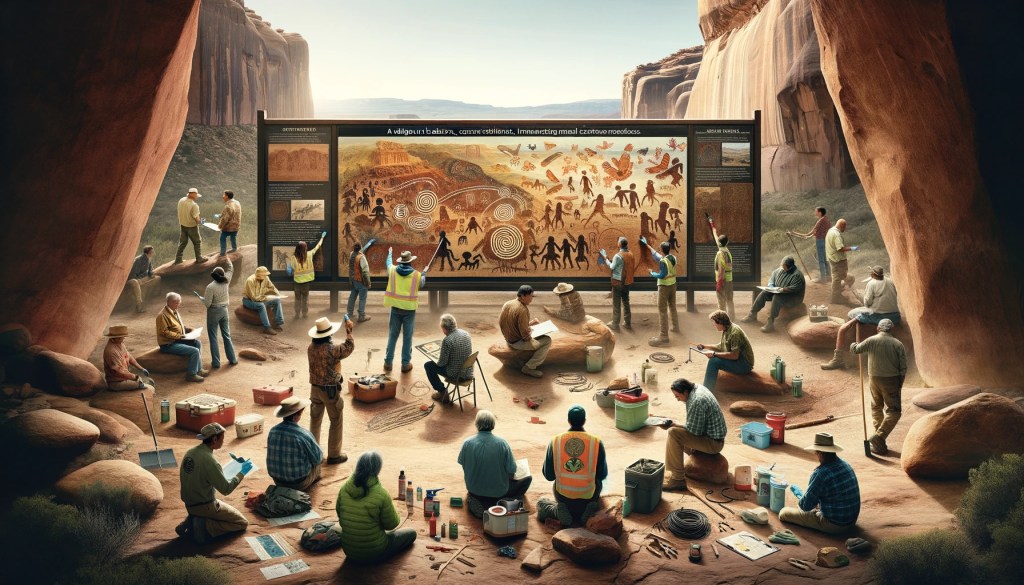
Importance of Preservation
The preservation of rock art sites is critical for several reasons:
- Cultural Heritage: These sites represent the cultural and spiritual heritage of the indigenous peoples of the region, containing symbols and narratives that are integral to their history and identity.
- Historical Significance: Petroglyphs and pictographs are primary sources of historical information, providing clues about the lifestyles, social structures, and environmental conditions of ancient societies.
- Artistic Value: Rock art is a form of ancient expression, showcasing the creativity and skill of artists who had limited resources but a profound understanding of their medium.
- Educational Resource: For educators, researchers, and students, these sites are outdoor classrooms that offer lessons in archaeology, anthropology, art, and environmental science.

Guidelines for Preservation
To ensure these ancient messages endure for centuries to come, visitors are encouraged to follow a set of guidelines designed to minimize human impact:
- Do Not Touch: The oils and acids from human skin can damage rock art. Even the slightest touch can accelerate the erosion of these ancient works.
- Respect Barriers: Fences and signs are placed to protect sensitive areas. Staying on designated paths and respecting barriers is essential for site preservation.
- No Rubbings or Castings: While it may be tempting to take a physical impression, these actions can cause irreversible damage to the art.
- Report Vandalism: If you witness acts of vandalism or come across newly damaged sites, report them to park authorities or local heritage organizations.
- Leave No Trace: Beyond rock art, the broader principle of leaving no trace ensures that the natural and cultural landscape remains as undisturbed as possible.
Collaboration for Conservation
Preservation efforts often involve collaboration between government agencies, indigenous tribes, conservation organizations, and the public. Initiatives may include documentation projects, the development of protective legislation, and public education campaigns aimed at raising awareness about the importance of rock art conservation.
By adhering to these guidelines and supporting preservation efforts, we honor the legacy of those who came before us and ensure that future generations can continue to learn from and be inspired by these ancient artworks. The preservation of Utah’s petroglyphs and pictographs is not only an act of respect for the past but a gift to the future, allowing continuous exploration, admiration, and study of these irreplaceable cultural treasures.
To enhance our understanding and appreciation of Utah’s petroglyphs and pictographs, incorporating Indigenous perspectives is crucial. These ancient artworks are not just historical artifacts; they are deeply embedded in the living traditions and spiritual life of Indigenous communities. These communities offer invaluable insights into the meanings, significances, and stories behind the rock art that no other source can provide.
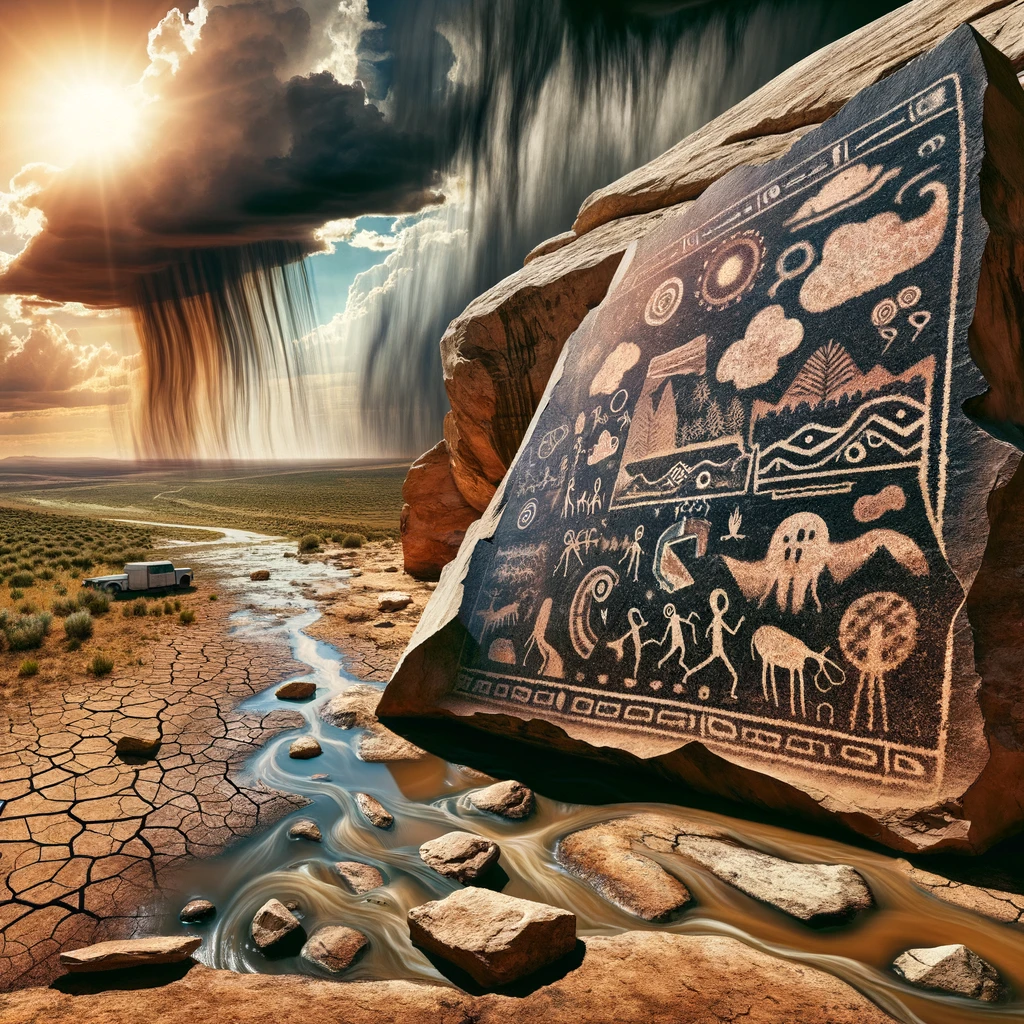
Indigenous Interpretations and Significance
Indigenous scholars and elders interpret these artworks as vital connections to their ancestors, land, and culture. They view petroglyphs and pictographs as more than mere symbols or ancient messages. Instead, they are seen as sacred texts, spiritual guides, and historical documents that speak of the peoples’ relationships with the earth, the animals, and the cosmos. For many tribes, these images serve as a bridge between the past and the present, offering lessons, wisdom, and guidance.
Cultural and Historical Context
From an Indigenous perspective, the petroglyphs and pictographs are expressions of cultural identity and continuity. They mark territories, record historical events, and convey spiritual beliefs and practices. For instance, the depiction of certain animals or celestial patterns can signify important ecological knowledge or cosmological principles. Understanding these contexts requires listening to the stories and interpretations passed down through generations within Indigenous communities.
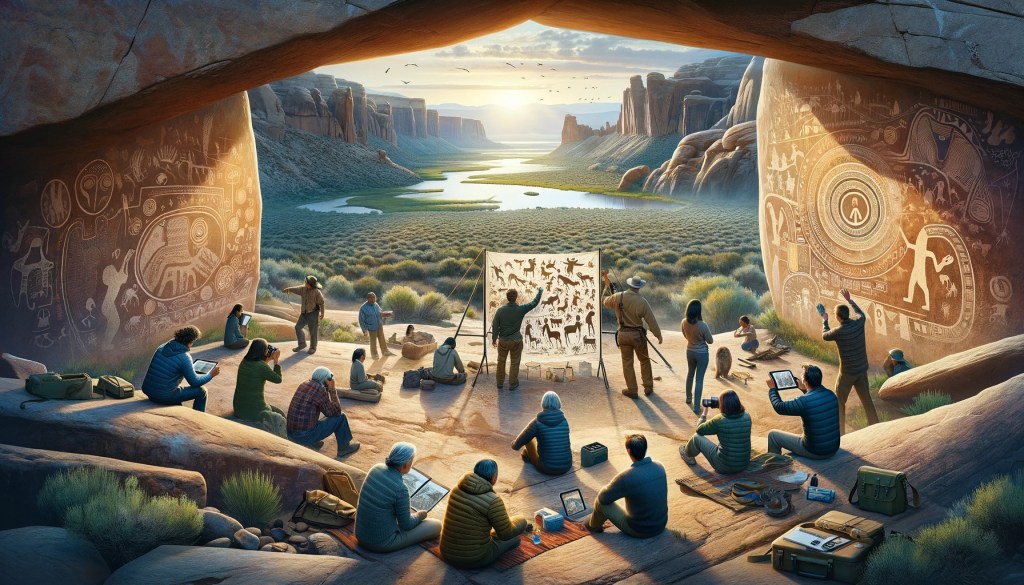
Preserving Indigenous Voices
Incorporating Indigenous perspectives involves actively engaging with Indigenous communities, respecting their knowledge and rights, and ensuring their voices are heard and prioritized in conversations about rock art. This includes acknowledging the sacredness of these sites and supporting Indigenous-led preservation efforts. It’s about building partnerships that respect Indigenous sovereignty and contribute to the revitalization of Indigenous cultures.
Challenges and Opportunities
One of the challenges in incorporating Indigenous perspectives is overcoming historical and ongoing marginalization. However, there are growing opportunities for collaboration in research, education, and conservation efforts. Museums, academic institutions, and preservation organizations are increasingly recognizing the importance of Indigenous knowledge in interpreting and caring for petroglyphs and pictographs.
By weaving Indigenous perspectives into our understanding of Utah’s petroglyphs and pictographs, we not only enrich our knowledge but also honor the deep connections between these artworks and the Indigenous peoples who continue to revere and protect them. This approach fosters a more holistic and respectful appreciation of these ancient messages, ensuring that the legacy of these artworks and the cultures they represent is preserved for future generations. Engaging with Indigenous perspectives transforms our relationship with these sites from one of mere observation to one of meaningful connection and mutual respect.
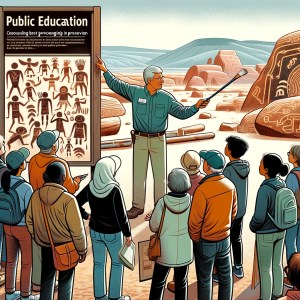
Conclusion
Utah’s ancient petroglyphs and pictographs stand as silent witnesses to millennia of human presence, thought, and spirituality. These enigmatic artworks, etched and painted on the rugged canvas of Utah’s landscape, encapsulate the profound connection between humanity and the natural world, between the earthly and the divine, and perhaps even between the known and the mysterious realms beyond our current understanding. They serve not only as a mirror reflecting the rich tapestry of human history but also as a beacon, illuminating the depths of human creativity and our ceaseless quest for meaning.
As custodians of this invaluable heritage, we are reminded of our responsibility to preserve these messages from the past so that they may continue to enlighten future generations. In the intricate lines and shapes of Utah’s rock art, we find the universal human yearning to communicate and connect—not just with each other but with the cosmos itself. These ancient artworks challenge us to expand our perspectives and to consider the broader narratives of our place within the universe.
In conclusion, Utah’s petroglyphs and pictographs are much more than mere historical artifacts; they are a vibrant testament to the enduring human spirit. As we explore these ancient messages, we engage in a timeless dialogue with our ancestors, seeking to understand the wisdom they have imparted upon stone and earth. Let us approach these sites with reverence and a commitment to their preservation, ensuring that this dialogue continues for generations to come.
- Transportation Services in Utah for Seniors and Individuals with Disabilities
- Unveiling the Mysteries of Skinwalker Ranch: A Utah Local’s Journey into the Paranormal
- Utah’s Hidden Gems: A Lifelong Local’s Guide to Utah Lost Treasures
- Ghost Towns in Utah: An Insider’s Guide to the State’s Abandoned Treasures
- Utah’s Dark Sky Marvels: A Guide to the Ultimate Stargazing Experience
- The Culinary Journey through Utah: Recipes of the Local Flavors of Utah
- Adventures in Utah’s Mighty Five: The National Parks of Utah
- The Artistic Pulse of Utah: Local Art and Music Scenes in Price and Helper










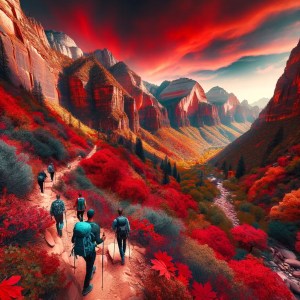
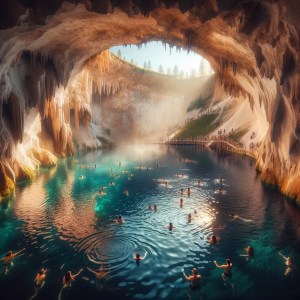




This entrance is fabulous. The magnificent substance reveals the maker’s energy. I’m shocked and anticipate more such mind blowing sections.
Thank you so much for the nice words! I am so glad you enjoyed this article.
This platform is phenomenal. The magnificent data uncovers the manager’s excitement. I’m shocked and expect additional such fabulous posts.
Thank you so much for the nice words! I am glad you enjoyed this article.
This is an amazing page. The outstanding information reveals the owner’s accountability. I’m in awe and eagerly await more amazing postings like this one.
Thank you so much for the nice words! I am glad you enjoyed this article.
“Gratitude is the foundation of a happy life, and your posts are the bricks that build that foundation. Thank you for the strength and stability!”
Wow wonderful blog layout How long have you been blogging for you make blogging look easy The overall look of your site is great as well as the content
I have read some excellent stuff here Definitely value bookmarking for revisiting I wonder how much effort you put to make the sort of excellent informative website
I have read some excellent stuff here Definitely value bookmarking for revisiting I wonder how much effort you put to make the sort of excellent informative website
Thank you so much for your kind words, Sabryna! A great deal of passion and dedication goes into each piece of content on the site. It’s always encouraging to hear that the information shared is valuable to our readers. Your bookmark is the highest compliment! Stay tuned for more articles that I hope will continue to inform and inspire your journey. Don’t hesitate to revisit and join our conversations in the Simply Sound Society forum—it’s a place where insights and ideas are always welcome!